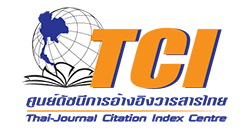การพัฒนารูปแบบความสัมพันธ์โครงสร้างเชิงสาเหตุของปัจจัยที่ส่งผลต่อประสิทธิผลของการทำงานเป็นทีม
Abstract
บทคัดย่อ การวิจัยในครั้งนี้ มีวัตถุประสงค์ 1) เพื่อพัฒนารูปแบบความสัมพันธ์โครงสร้างเชิงสาเหตุของปัจจัยที่ส่งผลต่อประสิทธิผลของทีม 2) เพื่อศึกษาอิทธิพลทางตรง อิทธิพลทางอ้อมและอิทธิพลรวมของปัจจัยที่ส่งผลต่อประสิทธิผลของทีม กลุ่มตัวอย่าง ประกอบด้วยโรงเรียนสังกัดสำนักงานเขตพื้นที่การศึกษา ในภาคตะวันออกเฉียงเหนือ จำนวน 550 โรง โดยทำการสุ่มแบบหลายขั้นตอน เครื่องมือที่ใช้ในการวิจัยเป็นแบบสอบถาม วิเคราะห์ข้อมูลโดยใช้โปรแกรมคอมพิวเตอร์สำเร็จรูป คำนวณหาค่าเฉลี่ย (M) ส่วนเบี่ยงเบนมาตรฐาน (S.D.) และการวิเคราะห์ค่าสัมประสิทธิ์สหสัมพันธ์ของเพียร์สัน และใช้โปรแกรมลิสเรล 8.30 ในการวิเคราะห์องค์ประกอบเชิงยืนยัน และตรวจสอบความสอดคล้องระหว่างรูปแบบสมมุติฐานกับข้อมูลเชิงประจักษ์ ผลการวิจัย พบว่า 1. รูปแบบความสัมพันธ์โครงสร้างเชิงสาเหตุของปัจจัยที่ส่งผลต่อประสิทธิผลของทีมในโรงเรียน สังกัดสำนักงานเขตพื้นที่การศึกษา ในภาคตะวันออกเฉียงเหนือ ที่ผู้วิจัยพัฒนาขึ้นมีความสอดคล้องกับข้อมูลเชิงประจักษ์ หลังจากการปรับแก้รูปแบบสุดท้ายด้วยค่าสถิติดังนี้ c2 = 27.36 , df = 49 , p-value = 0.99 , GFI = 0.99 , AGFI = 0.98 , RMSER = 0.00 , RMR = 0.0077 , CN = 1480.76 และค่า largest standardized residual = 1.98 2. ปัจจัยที่มีอิทธิพล ต่อประสิทธิผลของทีม โดยการเรียงลำดับค่าสัมประสิทธิ์อิทธิพลดังนี้ อิทธิพลทางตรงมี 3 ปัจจัย คือ ปัจจัยด้านการออกแบบทีม มีค่าสัมประสิทธิ์อิทธิพล เท่ากับ 0.57 ปัจจัยด้านกระบวนการของทีม มีค่าสัมประสิทธิ์อิทธิพล เท่ากับ 0.31และปัจจัยด้านภาวะผู้นำทีม มีค่าสัมประสิทธิ์อิทธิพล เท่ากับ 0.06, 2.2 อิทธิพลทางอ้อม มี 3 ปัจจัย คือ ปัจจัยด้านบริบทองค์การ มีค่าสัมประสิทธิ์อิทธิพล เท่ากับ 0.59 ปัจจัยด้านการออกแบบทีม มีค่าสัมประสิทธิ์อิทธิพล เท่ากับ 0.35 และปัจจัยด้านภาวะผู้นำทีม มีค่าสัมประสิทธิ์อิทธิพล เท่ากับ 0.23, 2.3 อิทธิพลรวม มี 4 ปัจจัย ดังนี้ ปัจจัยด้านการออกแบบทีม มีค่าสัมประสิทธิ์อิทธิพล เท่ากับ 0.92 ปัจจัยด้านบริบทองค์การ มีค่าสัมประสิทธิ์อิทธิพล เท่ากับ 0.59 ปัจจัยด้านกระบวนการของทีม มีค่าสัมประสิทธิ์อิทธิพล เท่ากับ 0.31 และปัจจัยด้านภาวะผู้นำทีม มีค่าสัมประสิทธิ์อิทธิพล เท่ากับ 0.29 คำสำคัญ: การพัฒนารูปแบบความสัมพันธ์โครงสร้างเชิงเสาเหตุ ประสิทธิผลของทีม Abstract: This research aimed to study the team effectiveness in schools under the Educational Service Area Offices in the Northeast of Thailand which the purposes of this research were : 1) to develop the linear structural equation model of the factors affecting the team effectiveness in the schools, and examine the goodness of fit between the models of factors affecting the team effectiveness which developed and the empirical data, and 2) to find out the direct, indirect and total effects of the factors affecting the team effectiveness. The multi-stage random sampling was applied for research sample which comprised 550 schools. The data were employed by using a questionnaire which earned data were analyzed to obtain mean ( ) ), standard deviations (S.D.) and Pearson’s product moment correlation coefficient. LISREL 8.30, was used for the confirmatory factor analysis and tested the goodness of fit between the hypothesis model and the empirical data. The research results found that : 1. The linear structural equation model of the factors affecting the team effectiveness in the schools which developed by the researcher was fitted with the empirical data. The statistic values of the final model were as follows : c2 = 27.36, df = 49, p-value = 0.99, AGFI = 0.98, RMSER = 0.00, RMR = 0.0077, CN = 1480.76 and the largest standardized residual = 1.9. 2. The factors which were direct, indirect and total effects on the team effectiveness which ordered from high to low of the influence coefficients as follows: The direct effect had three factors : team designing with the influence coefficient of 0.57, influence coefficient of 0.31 for the team process and team leadership with the influence coefficient of 0.06. For direct effect, there were three factors : organizational context with the influence coefficient of 0.59, team designing with the influence coefficient of 0.35 and team leadership with the influence coefficient of 0.23. There were four factors in the total effect : team designing with the influence coefficient of 0.92, organizational context with the influence coefficient of 0.59, team process with the influence coefficient of 0.31 and team leadership with the influence coefficient of 0.29. Keywords: Development of structural relation model, Team effectiveness �������������������������������������������������������������������������������������������������������������������������������������������������������������������������������������������������������������������������������������������������������������������������������������������������������������������������������������������������������������������������������������������������������������������������������������������������������������������������������������������������������������������������������������������������������������������������������������������������������������������������������������������������������������������������������������������������������������������������������������������������������������������������������������������������������������������������������������������������������������������������������������������������������������������������������������������������������������������������������������������������������������������������������������������������������������������������������������������������������������������������style='font-size:14.0pt;font-family:"Browallia New","sans-serif";color:black'>in each, and overall aspects was rate at the “much” and higher than the set criteria at the level of 0.05 was statistically significant. Keyword: academic services of higher education institutions, enhancement of learningDownloads
Download data is not yet available.
Downloads
Issue
Section
บทความวิจัย




